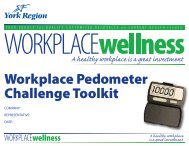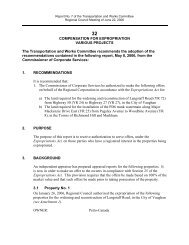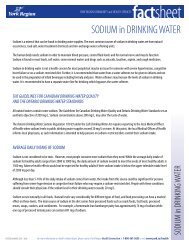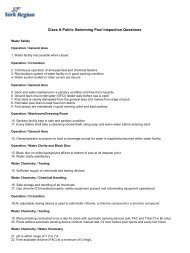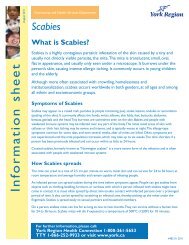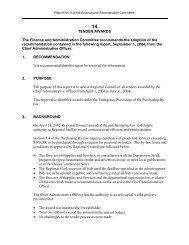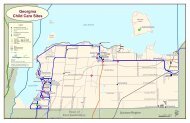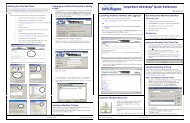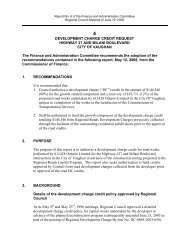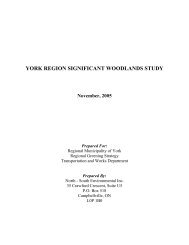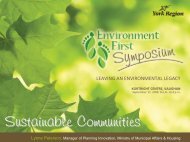Changing Landscapes: Recent Immigrants Living in York Region
Changing Landscapes: Recent Immigrants Living in York Region
Changing Landscapes: Recent Immigrants Living in York Region
You also want an ePaper? Increase the reach of your titles
YUMPU automatically turns print PDFs into web optimized ePapers that Google loves.
Appendix 3: Methodology<br />
<strong>Chang<strong>in</strong>g</strong> <strong>Landscapes</strong>: <strong>Recent</strong> <strong>Immigrants</strong> <strong>Liv<strong>in</strong>g</strong><br />
<strong>in</strong> <strong>York</strong> <strong>Region</strong> is primarily based on a series of<br />
Statistics Canada 2006 Census custom tabulations.<br />
The report focuses on the socio-economic<br />
characteristics of <strong>York</strong> <strong>Region</strong>’s recent immigrant<br />
population, and compares social and economic<br />
attributes of immigrants from different periods of<br />
immigration with non-immigrants, where data is<br />
available. The report also compares characteristics<br />
of recent immigrants <strong>in</strong> <strong>York</strong> <strong>Region</strong>, across<br />
other GTA municipalities (Toronto, Peel, Halton,<br />
Durham), Ontario and Canada to provide a broader<br />
picture. Where possible the report highlights<br />
comparisons between recent immigrants <strong>in</strong><br />
<strong>York</strong> <strong>Region</strong> who arrived <strong>in</strong> 2001 and those who<br />
arrived <strong>in</strong> 2006.<br />
The Statistics Canada 2006 Census data is the<br />
most recent detailed data on social and economic<br />
characteristics, provid<strong>in</strong>g detailed “po<strong>in</strong>t <strong>in</strong> time”<br />
data on recent immigrants. Throughout the<br />
report the data is augmented, where possible,<br />
with more recent research papers, such as the<br />
<strong>York</strong> <strong>Region</strong> Local Immigration Partnership:<br />
Summary of Community Consultations and<br />
Literature Review (2011), <strong>York</strong> <strong>Region</strong> Ag<strong>in</strong>g<br />
Workforce F<strong>in</strong>al Report (2011), Statistics Canada’s<br />
study on migration from central to surround<strong>in</strong>g<br />
municipalities (Turcotte & Véz<strong>in</strong>a, 2010), Statistics<br />
Canada Labour Force Study (2008 to 2009), and<br />
Citizenship and Immigration Canada Land<strong>in</strong>g Data<br />
(2006 to 2008).<br />
Def<strong>in</strong>ition of <strong>Recent</strong> <strong>Immigrants</strong>:<br />
Statistics Canada def<strong>in</strong>es immigrants as “People<br />
who are, or have been, landed immigrants <strong>in</strong><br />
Canada. A landed immigrant is a person who<br />
has been granted the right to live <strong>in</strong> Canada<br />
permanently by immigration authorities. Some<br />
immigrants have resided <strong>in</strong> Canada for a number<br />
of years, while others have arrived recently.<br />
Most immigrants are born outside Canada, but a<br />
small number were born <strong>in</strong> Canada.” (Statistics<br />
Canada, 2010, p. 28).<br />
For the purpose of this report, recent immigrants <strong>in</strong><br />
2006 are considered to be those who immigrated<br />
to Canada dur<strong>in</strong>g the five-year time period<br />
from 2001 to 2006. When appropriate, recent<br />
immigrants <strong>in</strong> 2006 are compared to immigrants<br />
from different immigration periods: 1996 to 2000,<br />
1991 to 1995 and prior to 1991.<br />
There is an <strong>in</strong>creas<strong>in</strong>g number of temporary<br />
workers and foreign students across the prov<strong>in</strong>ce<br />
and Canada. In <strong>York</strong> <strong>Region</strong>, there were 7,170<br />
non permanent residents <strong>in</strong> 2006, who were not<br />
<strong>in</strong>cluded <strong>in</strong> the analyses conducted for this report.<br />
Also, some of the immigrants <strong>in</strong> the analysis,<br />
while def<strong>in</strong>ed as “recent immigrants” because they<br />
received their permanent residency status between<br />
2001 and 2006, may have been liv<strong>in</strong>g <strong>in</strong> Canada<br />
with other status (such as temporary workers and<br />
foreign students) for more than five years.<br />
<strong>Chang<strong>in</strong>g</strong> <strong>Landscapes</strong>: <strong>Recent</strong> <strong>Immigrants</strong> <strong>Liv<strong>in</strong>g</strong> <strong>in</strong> <strong>York</strong> <strong>Region</strong><br />
112



